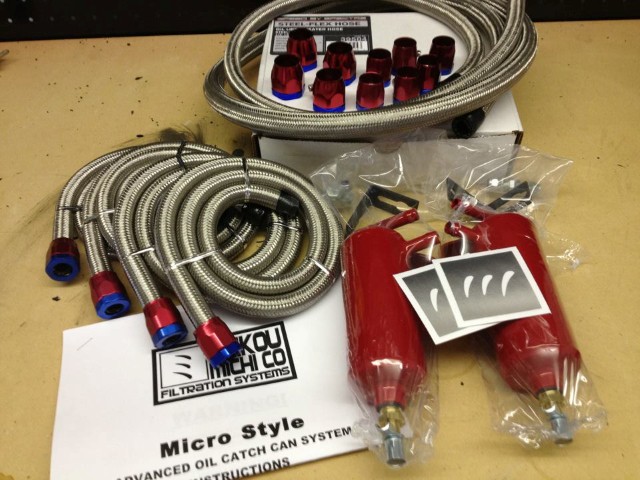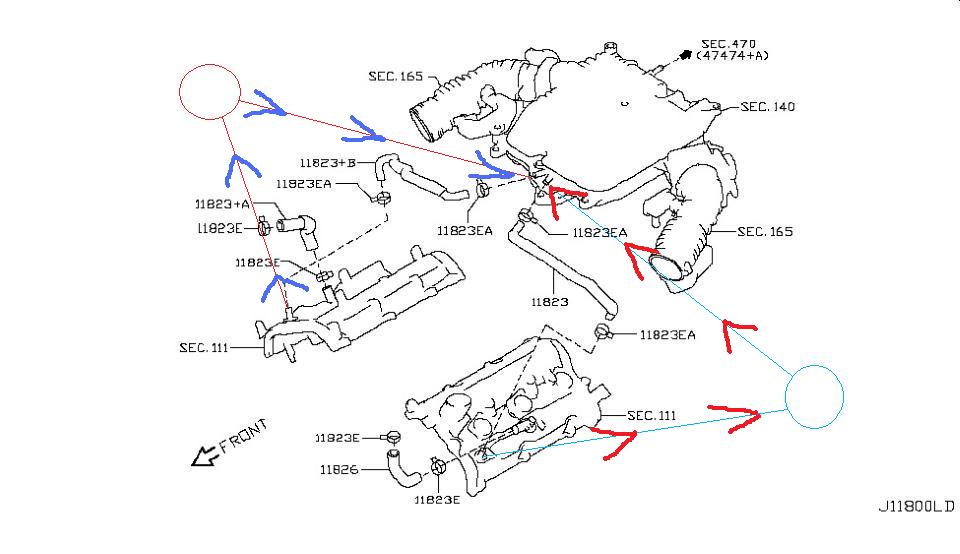Disclaimer: This is primarily for the extreme novice, like me, so hard core types will find this simple and rather boring. I spent alot of time researching this, so am only trying to help others with similar skill set as mine save time in the future. There are several good threads about catch cans, but none that were specifically dual cans on an NA motor with the stock intake manifold.
This is a photo showing all the parts I ordered to do this.
 Why bother doing this ?
Why bother doing this ?
The 370Z has dual intake inlets that suck in blow by gases from the PCV valves. One for each side of the motor (annotated diagram below). These blow by gases can create damaging carbon and oil sludge build-up in your intake, including your intercooler for you FI guys. Even NA motors (like me) can benefit from using catch cans. I have read that NA guys trap just as much oil as FI guys, so not a bad idea for either platform. Less oil in your intake also reduces the risk of detonation. This is primarily due to less degradation of the octane rating of the gasoline you are using while it burns away. In theory, this would enhance performance. Improved reliability and health of the engine for increased longevity. I could find no cons to doing it, besides creating another routine maintenance chore and cost.
Props to
wstar for some great information about how the entire PCV system works in his
DIY-Oil Catch Can thread, and also for taking the time to answer some PMs from me while I was researching this.

There is another thread that
talks to the advantages of catch cans along with some more PCV insight.
Why two cans instead of one ?
Being a retired military dude, I learned to never "half azz" anything. Either go big, or GTFO. Mainly I chose two because the motor has two separate closed breathing routes ... one on each side of the motor. You could combine those lines, and run one can, but I felt more comfortable letting it breathe the way it was intended. Also consider that the smallest opening in the system is what limits the flow of gasses to the can, which is why I stopped considering one can by using a T connection ... the T connection becomes a minor restriction as well as reducing two hoses into one. Also make sure the fittings on the can(s) are matched to your hoses. Plus, I am anal about things being "uniform" ... so if I do something on the right hand side of the engine bay, by golly we have to do the same thing on the other side to kind of balance things out and make it look pretty. I am also lazy by nature, so I figure I will have to check them and empty them two times less often as compared to one can twice as much. It is an added maintenance chore, but well worth the benefits.
Why Saikou Michi ?
Many catch cans on the market today are just empty cans with an inlet and an outlet. If you are going to use one of those types, you might as well empty out a coffee can, spray paint it black and hook up some NPT nipples to it and you are good to go. While they do trap some oil, they are not really as effective as a truly baffled can. The air entering the can is escaping fast and returning to the intake manifold, though heat and condensation do allow them to catch some oil. The cans I chose are truly baffled. On top of being baffled, they are also "micro" filtered ... so twice the opportunity to eliminate the oily nasties before they exit the can. I noticed a few GTR guys using these, along with many Lotus and Corvette owners. I figured if they are good enough for those rides, they are good enough for me. They are also made in the U.S.A., are priced at nearly the same price point as many of the empty do nothing can's out there, and are 100% custom made how ever you want it. This includes color, orientation of the inlet and outlet, how big it is, any custom bracket you want to mount them with and some pretty cool looking decals. I basically had to fill out a nifty configurator worksheet that they then used to manufacture the cans. There are other baffled choices out there, but I liked dealing with these guys ... they operate in a very personal, hands-on customer oriented way. The packaging and quality of the cans was top notch. Lead time from order placed to product shipped was about 2 weeks. I chose the Micro Style OCC, mainly to use up less space and they are super light. Saikou Michi also uses a "thin wall technology" they use to manufacture the cans, which results in a super lightweight end product. I have included a link to the cans below in the parts list.
What are all the parts shown in your picture and where do they go ?
At the same time I am installing the catch cans, I am replacing all the crankcase breather hosing with stainless steel. Therefore, this could obviously be done for a lot cheaper using either silicone, or some other rubber hosing. I opted for the bling affect that SS lines give me.


In the diagram above I used my mad paint skills to add a red circle on the left, and a blue circle on the right. These represent the left, and right oil catch cans. So for the right, or blue circle ... hose 11823 enters the right side "V" at the intake manifold ... this will come from the outlet of the blue can. You will enter the input of the blue can with another line, from where hose 11823 currently exits the motor.
For the red circle side, same thing, only the hose is 11823+B. From the left intake manifold "V" to the outlet of the catch can, out of the catch can to the nipple where hose 11823+B currently terminates.
These connections are all 3/8" ID at the intake manifold and where they return to the motor. I ordered my catch cans with the same size NPT nipples, so that makes a total of eight (8) 3/8" ID connection points.
As such, I ordered four (4) 3' lengths of hose with eight (8) 3/8" clamps. You actually get two clamps with each 3' hose so it worked out a little better to get the 3' sections as opposed to 2' bare sections and then buying the clamps separately. Better to have too much hose, than not enough, so I plan on trimming it down all pretty once everything is in place where I want it.
Now, as I mentioned, I am replacing the other breathing hose as well. These have nothing to do with the catch cans, but in case you want to change them out I am including what I did. These are hoses 11826 on the right, and 11823+A on the left. These both go between the motor and to either your stock intake boxes, or to your CAI. In my case I have a Typhoon, so these go from the motor to the underside of my CAI. They are 1/2" ID at both connections. So, I ordered a 4' (was the shortest I could get in half inch) hose section and four (4) 1/2" clamps. I will trim it up to do both sides. This stuff is supposedly easy to cut, tho I have not actually cut any yet. It's rated up to heater hose, so maybe I can use the left over to do something else.
I ordered all of the hose and clamps from Spectre Performance directly. I liked the AN style connectors that are just AN look alikes with a worm gear clamp built inside of them. Because of the plastic nipples on the intake manifold, there was really no way to go with a true AN style connection, and that would have been much more expensive anyway.
Complete Part List
(2) Micro Style OCC with 3/8" NPT fittings from
Saikou Michi
(4) Spectre SS 3/8 ID 3' Hose 29490
(8) Spectre SS 3/8 ID Clamps (comes with part number 29490)
(1) Spectre ½ ID SS Hose 4' 39504
(4) Spectre SS ½ ID Clamps 3160
...now I will move onto mounting location considerations, and start planning the line runs.